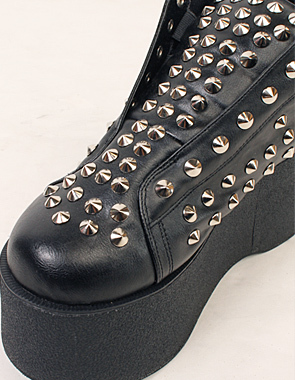 |
| picture by http://www.netvivi.cc/coordinate.php?magazine_id=5242 |
 |
| picture by http://store.wego.jp/products_detail.html?product_id=21364 |
these days, shoes that have thick soles are in trend in HARAJUKU fashion style.
we call them POKKURI GUTU.
POKKURI means thick-chubby, GUTU stands for shoos.
 |
| picture by fashionsnap.com |
At that time, wearing mini skirts with thick-soled boots was on trend.
it was popularized by NAMIE Amuro, the famous Japanese artiest.
she is still famous now.the people who wanted to look like her were called AMURA.
but this style had died since 1996, and for a while, 'valet' shoos which had none heels appeared.
 |
| picture by http://www.tombow.gr.jp/school/change/report/14_04.htm |
 |
| picture by http://cls2008.blog118.fc2.com/blog-entry-39.html |
 |
| arranged style at NAMIE AMURO's concert picture by http://www.hotexpress.co.jp/live_report/amuronamie_20060131/ |
and now it's become a standard item in summer.
and for the past 3 years, retro styles such as those in the1990's,1980's of France have became popular, and Japanese like to wear romantic styles.
the fashion during those times, the French liked to wear vivid colors wiz high heels.
This featured heels that were separated from the sole under the toes and balls of the feet, in contrast to "Wedge Sole".
these shoos made the figure of leg upper more beautiful and feminine.
 |
| picture by http://www.buyma.com/item/6090189/ |
and now, POKKURI shoos came in.
these kinds of shoes are standard items for punk rock-ish styles named 'Visual style' and for 'Lolita fashion style'.
Lolita fashion features Victorian-era clothing as well as costumes from the Rococo period.
these styles were not very popular, and were not very used.
 |
| Visual style |
 |
| picture by http://tokyofashion.com/pink-hair-sexy-dynamite-london-platform-creepers-harajuku/ |
 |
| Lolita style |
 |
| picture by http://tokyofashion.com/japanese-lolita-baby-the-stars-shine-bright-red-tartan-jsk-harajuku/ |
and there was big difference between HARAJUKU style and Visual-Lolita style, so
the latter hadn’t been published.
From this, you can say that the mix style is now developing, and the categories of fashion are increasing.
I don't have these kinds of shoes yet, but I'm looking for this one
I don't have these kinds of shoes yet, but I'm looking for this one
She was a fashion model but she became a leader of its brand.
she has a sense of American casual style.
she has a sense of American casual style.
But she doesn't like the general style, such as red checkered print shirts and worn-out pants.
she tried to mix it with the HARAJUKU style, and this effort was a success.
now it’s brand grows and has a store at the center of SHIBUYA, where, for young people, is one of the busiest street in japan.
now it’s brand grows and has a store at the center of SHIBUYA, where, for young people, is one of the busiest street in japan.
 |
| picture by http://fashionjp.net/soen/fashion/news/wc111122/ |
 |
| pictures by http://wakatsuki-chinatsu-wc.jp/us/index.html |
I often check the sellers' blogs.
if u have any questions, add a comment!
LOVE ALISSA
LOVE ALISSA










































